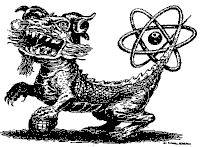The Polish Ecological Club against Mochovce nuclear power plant
MOHOVCE SAFETY REPORT 'HOPELESS'
Kraków, 6 Jan. 1995
Polish environment group Polski Klub Ekologiczny (the Polish Ecological Club, Friends of the Earth - Poland) after a preliminary review of the environmental impact assessment of the Mohovce nuclear power plant, has damned the document as hopelessly inadequate.
The Mohovce project consists of two Soviet - designed 'VVER-213' nuclear reactors which are now 80-90% complete. Slovak electric utility SEP plans to complete them with the credit of the EBRD and Euratom. An international joint venture has been formed with Electricite De France for this purpose. According to PKE, the EIA safety documentation fails completely to provide the most important safety - related detail, while providing large quantities of irrelevant information on topics of minor importance.
According to a PKE analyst, John Hallam: "Before we started to look at the Mohovce safety report, we knew there were a whole series of long - standing concerns about VVER safety. The safety report reflects none of these concerns". For example, a 1989 US Department of Energy analysis of VVER safety came up with a number of concerns which are valid to this day, and are still not properly addressed. They include:
-- The susceptibility of the reactor pressure vessel to radiation induced embrittlement. Because the fuel in VVER reactors is closer to the walls of the reactor pressure vessel than in western reactors, VVER reactor pressure vessels become brittle faster due to the impact of neutrons, than do the vessels of other reactors, though vessel embrittlement is also an issue in older US reactors. The safety report actually admits in a couple of places that the susceptibility of the reactor pressure vessel to neutron embrittlement needs 'examination'', yet the very existence of the issue for VVERs is not mentioned, and nowhere are details given on all the things one would like to know such as the alloy composition of this particular pressure vessel and hence its susceptibility to this kind of problem, and the kind of core design that will be chosen.
-- Reliability of the Emergency Shutdown (Scram) System VVERs seem to have a slow and possibly unreliable system to insert the control rods in an emergency. A fast and reliable emergency shutdown (Scram) system is essential for reactor safety, yet in certain circumstances, for example, in case of an electrical fault, the scram system in a VVER213 reactor may not work at all. The EIA Safety Report should have provided details of the kind of emergency shutdown system installed, and of whether they plan to alter it None of these crucial safety details are in the report.
Other matters raised in the 1989 DOE report include the effectiveness of the confinement and 'bubbler tower' system, the vulnerability of the plant to an aircraft crash, protection from flying debris in case of the self - destruction of one of the plants turbo - generators, and the effectiveness of the emergency core cooling system.
In addition, the Mohovce plant could become a target for terrorist activity as it lies in a potentially unstable part of the world, a possibility not even mentioned in project documentation.
The safety report contains no real analysis of any of these matters. Rather, it tends to concentrate on secondary matters such as pipe - whip, fire protection, and a number of piping changes which it fails to explain properly.
It also lacks basic information. For example, nowhere does it contain a diagram of a VVER plant, let alone this particular VVER plant. Nor does it contain proper site or layout maps.
Finally, the 'detailed' appendices to the report display a fragmented approach, reading as if no - one had ever taken a look at the whole thing to see how it fitted together. The approach is also frequently legalistic, with the authors more concerned to demonstrate that they satisfy the letter of Soviet or Slovak or IAEA requirements than that what they plan is actually the best and safest thing to do.
It is our opinion that the EBRD and the governments concerned should take a very dim view of this thoroughly unsatisfactory document, and throw it out, and the whole Mohovce project with it.."
Tomasz Terlecki
Kraków, 17th Feb. 1995
Polski Klub Ekologiczny, Polands largest and oldest environmental organisation, submitted on 17th Feb. 1995 its formal comments on safety aspects of the Mochovce nuclear power plant to the EBRD, Slovensky Energetiky Podnicky (SEP), and Electricite De France (EDF). Friday 17th was the formal end of the public participation process being held by the EBRD under its environmental protection guidelines.
PKE and 20 international environment groups including FOE International, Greenpeace, and Global-2000 have lobbied strongly for the period of public participation to be extended for 30 days, on the basis that the process has been flawed and that the documentation is inadequate.
In addition, PKE argues that the safety and EIA documentation released by the project proponents, SEP and EDF, is so bad that it should be withdrawn and the entire process of public participation should be started again. According to PKE, the safety documentation in particular, contains such gross deficiencies that it is totally unsuitable for use as a basis for public comment.
The documentation actually fails to even acknowlege the existence of major safety problems that are common to all VVER power plants, let alone deal with them in any acceptable way. These problems include neutron embrittlement of the reactor pressure vessel, an unreliable emergency shutdown system, and an 'accident localisation system' that,according to calculations done in Poland, will collapse if exposed to the stresses of a major acccident.
Comments by Professor Niewodniczanski on Polish national TV last night to the effect that PKE is ignorant and doesn't know what we are talking about, neglect a few important matters. PKE has relied heavily in its analysis on material from two sources: from the IAEA, who surely can't be accused of ignorance, and on analyses done for the IAEA by Janislaw Zwolinski and Leon M. Kolodziejczk in 1989-90. These people were then asssociated with Warsaw Technical university and the Polish Atomic Energy Commission of which Professor Niewodniczanski is the head. ggProfessor Niewodniczanski's should desist from this kind of politically motivated comment, and should start by actually reading what PKE has said, and consult Zwolinski and Kolodziejczk, who have done the analyses for the IAEA.
A major accident at Mochovce could happen if the reactor pressure vessel at Mochovce cracked, which might happen due to neutron embritttlement. A sufficiently big accident could produce a radioactive plume up to 1000Km long (the plume from Chernobyl was 1500Km), which would contaminate not only the whole of Slovakia with a SW to NE wind, but the whole of Southeast Poland, including Cracow, Bielsko, and up to the Byelorussian border.
This means that it is very much in Poland's interest to ensure that the Mochovce project does not proceed. The Polish governmment must act in conjunction with that of Austria to impress on Slovakia that the completion of Mochovce, either via the EBRD or by other means is unacceptable and would create an international issue.
Polish Ecological Club - National Board
ul. Piłsudskiego 8, 31-109 Kraków, Poland
tel./fax: 48/12/21.88.52
E-mail: uedabrow@kinga.cyf-kr.edu.pl

reprinted from WISE no 421






 Wydawnictwo „Zielone Brygady” - dobre z natury. Niektóre prawa zastrzeżone.
Wydawnictwo „Zielone Brygady” - dobre z natury. Niektóre prawa zastrzeżone.